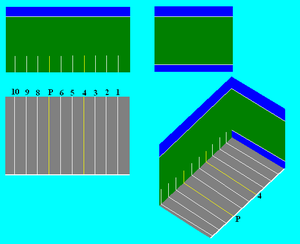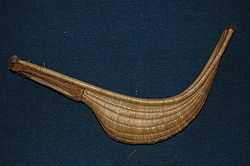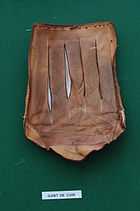Basque pelota
 A game of pelote as played in Ustaritz | |
| Highest governing body | International Federation of Basque Pelota |
|---|---|
| Nickname(s) | Pelota |
| First played | 13th century |
| Characteristics | |
| Contact | No |
| Team members | Single or doubles |
| Categorization | Hand Sport, Racquet sport, Basket Sport |
| Equipment | Basque pelota ball |
| Presence | |
| Olympic |
Part of the Summer Olympic programme in 1900 Demonstrated at the 1924, 1968 and 1992 Summer Olympics Recognized as an Olympic sport |
Basque pelota (pilota in the original Basque language also pelota vasca in Spanish, pelote basque in French) is the name for a variety of court sports played with a ball using one's hand, a racket, a wooden bat or a basket, against a wall (frontis or Fronton) or, more traditionally, with two teams face to face separated by a line on the ground or a net. The roots of this class of games can be traced to the Greek and other ancient cultures.[1]
The term pelota probably comes from the Vulgar Latin term pilotta (ball game). It is a diminutive form of the word pila which may relate to a hard linen or leather ball filled with pilus (fur or hair)[2] or to the Latin words for strike or spade and is related to the English word pellet.[3]
Today, Basque pelota is played in several countries. In Europe, this sport is concentrated in Spain and France, especially in the Basque Country and its neighbouring areas. The sport is also played in Latin American countries such as Argentina, Chile, Cuba, Mexico, Perú and Uruguay. Operated as a gaming enterprise called Jai Alai, it is seen in parts of the U.S. such as Florida, Connecticut, Nevada, and Rhode Island.
In Valencia, Valencian pilota is considered the national sport; it is also played in Belgium, North of Italy, Mexico, and Argentina.
Since its creation, the International Federation of Basque Pelota has standardised the different varieties into four modalities and fourteen disciplines, with fixed ball weights, rules and court sizes. The four modalities (30 m wall, 36 m wall, 54 m wall and trinquete) admit fourteen disciplines, depending the use of bare hand, leather ball, rubber ball, paleta (pelota paleta), racket (frontennis) and xare. Two of the fourteen disciplines are played by both men and women (frontenis and rubber pelota in trinquete); the other twelve are played only by men.
This allows championship play at the international level, and allows the participation of players and teams from around the world using the same rules.
There is, however, criticism about this, since purists might argue that some of the original traits of each particular modality could be lost.
History
The origin of this sport is tied to the decline of the ancient jeu de paume (jeu de paume au gant), ca. 1700. While the game evolved to the modern jeu de paume (with racquet, called real tennis in England) and eventually to tennis, rural alpine and pyreneean communities kept the tradition.
In the basque country the "pasaka" and "laxoa", local versions of the paume evolved to the peculiar style of the pilota: instead of playing face to face, with a net in the midfield, the basques began to fling the ball against a wall.
According to the basque pilota historian Chipitey Etcheto, the first recorded matches took place in Napoleonic times; it is believed that the game was close to currently rare specialty of "rebot".
The mid-19th century saw the explosion of the "pelota craze". The player "Gantxiki" is considered the original "father" of the chistera, the basket-shaped racquet which can propel the ball at incredible speeds, introduced around 1850.
The top champions of the end of the 19th century, like "Chiquito de Cambo" were immensely popular and the best paid sportsmen of their time. The first official competitions were organized in the 1920s, and led to the world championship in the 1950s.
International projection
Basque pelota was an official Olympic sport once, in the 1900 Paris Games, and a demonstration sport in 1924 (men), 1968 (men) and 1992 (men and women). See also Basque pelota at the 1900 Summer Olympics.
Although this sport is mostly played in Spain and France, there are also federations of Basque ball in Argentina, Bolivia, Brazil, Canada, Costa Rica, Cuba, Chile, Dominican Republic, Ecuador, El Salvador, Philippines, Guatemala, Italy, Mexico, Paraguay, Peru, Puerto Rico, Uruguay, United States, Venezuela, Netherlands, Sweden, India and Greece. Due to the origin of the game, there are many good players who are Basques, either natives or from the Basque diaspora.[4]
Playing area
Basque pelota is usually played in a two walled court (Basque: frontoi or pilotaleku, French: fronton, Spanish: frontón). As seen in the picture, there are also courts with one wall, a modality prevailing on the French side of the Basque Country, some spots of Navarre or at the highly exceptional court of Zubieta in province Gipuzkoa. Yet they are not recognized by the International Federation of Basque Pelota for international tournaments, and usually reserved to joko-garbia and open-air grand chistera games.
Rules (hand pilota)

The basic principle in hand-pelota is that there are two teams of two players each. The team to serve bounces the ball, then propels it towards the playing area of the narrow, front wall where it has to rebound between the low line demarcating the low off-area and the high line demarcating the high off-area.
The ball may either be played so it rebounds directly off the front wall onto the playing floor or onto the long side wall first. The opposing team may either play the ball immediately after rebounding from the front wall or side wall without rebounding from the playing floor or after having rebounded from the playing floor once.
A team scores by:
- playing the ball in such a way that the opposing team is unable to play the ball before it has rebounded off the playing floor more than once.
- playing the ball in such a way that it rebounds off the front wall and rebounds off the floor and outside the playing area.
A team may also score by the opposing team:
- hitting the front wall but either below the low line or above the high line.
- hitting the ball in time but failing to reach the front wall.
Modalities
Hand-pelota (Official International Specialty)
(Basque: esku huska or esku huskako pilota, Spanish: pelota a mano): played barehanded (or with minimal protections) and with a traditional ball made of wool around a hard core and covered with leather. The standard ball should weigh 92–95 grams. It is played in the short court either individually (one vs. one) or by pairs (two vs. two). Traditionally and professionally it is reserved for men. Players can be distinguished by the swelling of their hitting hand. It was originally played in the 13th century in the Basque reigon of Spain, and has been played for a long time in Mexico, South America, Cuba, Italy and many US states, including Florida.[citation needed] The sport is similar to squash, players hit the ball against the end wall of a three-sided court, trying to get the ball out of the opponent's reach.

Paleta Goma (rubber)
Like paleta balina but played with the "spanish" solid rubber ball.
Paleta Goma (Rubber – Official International Specialty)
Also called "Argentine Paleta Goma", this is played with a short and broad wooden bat, called paleta in both Spanish and Basque, and a gas-filled rubber ball. The ball is neither solid nor hollow. It is made from two halves glued together. Before being glued, the core is filled with a special gas which gives the ball firmness and bounce, and thus greater speed. Paleta Goma can be played by either men or women. This version of paleta was invented in Argentina and is widely played there. The Argentine male pelotaris are used to dominate international competitions.

Paleta Cuero (leather – Official International Specialty)
This variant is played with a bat similar to the previous one but with a traditional leather ball. This game is mainly played by men.
Pala Corta (short bat – Official International Specialty)
This is played with somewhat shorter but thicker and much narrower bat (pala ancha). The ball is leather or rubber. It is reserved, in principle, for men.
Pala (long bat)
Is played with a longer bat (pala larga), again thick and not much wide. Leather or rubber ball in the long court. In principle, this game is reserved for men.

Jai alai (zesta punta – Official International Specialty)
This is the version known outside Europe as jai alai. It is called zesta punta in Basque[5] and cesta-punta in Spanish (literally: 'edged basket'). It uses a special glove that extends into a long pointed curved basket (hence the name), circa 60 cm long in straight line and 110 cm by curved line. The basket (xistera in Basque and chistéra in French) was introduced by Gantchiqui Dithurbide from Saint-Pée, France in 1860,[6] and its long version by Melchior Curuchage, from Buenos Aires in 1888.[6] The players use it to catch the rubber ball and propel it back against the main court. The Basque Government claims it as "the fastest game on Earth", the record being 302 km/h or 187.65 mi/h (José Ramón Areitio at the Newport Jai Alai, Rhode Island, USA on 3 August 1979[6]).
Joko-Garbi
A variant of the above. The basket-glove is shorter and less deep and it is allowed to retain the ball only momentarily. The Basque name joko garbi means "clean game", in opposition to the abuse of atxiki, typical of the late 19th century style of playing, dubbed joko zikin ("dirty game").
This game is for men only.
Remonte
Similar to joko-garbi, but the xistera is even more flat and don't allow the atchiki foul. This game, like pasaka, laxoa and rebot, is seldom performed.

Xare (Official International Specialty)
Uses a simple soft racket (sare or xare meaning "net" in Basque). It is played only in the trinquet court. This speciality is known for the quick, precise and sharp movements of the pelotaris who are capable of reaching balls considered impossible for pelotaris of other specialities. It is also traditionally strong in South American countries.
Frontenis (Official International Specialty)
It is a modern Mexican fusion between tennis and Basque pelota. It uses tennis rackets in a short court, although the ball has a different surface to the tennis one. Men and women both play this game.
Professional games
Professional games on Basque Country are mainly controlled by Asegarce and ASPE that hold the contract of the tournament players.
In the United States pelota is mainly a professional sport, strongly tied to betting and the pari-mutuel system.
In professional environment is common to play special plays called "quinielas" well adapted to the betting needs.
Main Tournaments
- 1st Hand-pelota, singles category
- 1st Hand-pelota, doubles category
- Cuatro y Medio
- 2nd Hand-pelota, singles category
In 1994, the production company Asegarce started painting the courts green so that the ball would be more visible on TV.[7]
Renowned players
Active
- Barriola
- Oinatz Bengoetxea
- Gonzalez
- Martínez de Irujo
- Olaizola II
- Patxi Ruiz
- Titín III
- Waltari
- Xala
Retired
- Artamendi
- Atano III
- Azkarate
- Beloki
- Patxi Eugi
- Mondragonés
- Ogueta
- Retegi I
- Retegi II
- Txikito de Iraeta
- Txikito de Eibar
- Gantxiki Dithurbide
- Chiquito de Cambo (Joseph Apestegi)
- Léon Dongaitz
- Marco "Akuma" Correia (Azores)
- Otharé Borda
- Jean Aguer
- Jean Urruty
Professional games are open to betting on the results, as usual in most traditional Basque competitions. In the USA and Macau it is mainly this aspect of the competition that has given it some popularity. Besides the federations, there are professional competitions such as the League of Companies of Basque Pilota. The International Jai-Alai Players Association is a union defending the players of Jai Alai.
World Championships of Basque Pelota
Since 1952, the International Federation of Basque Pelota has organized the World Championships of Basque Pelota.
Medal count
The current historical medal count since 1952 to 2010 is as follows:[8][9][10]
| Nation | Gold | Silver | Bronze | Total | |
|---|---|---|---|---|---|
| 1 | | 62 | 52 | 39 | 153 |
| 2 | | 60 | 67 | 32 | 159 |
| 3 | | 45 | 23 | 13 | 81 |
| 4 | | 40 | 37 | 25 | 102 |
| 5 | | 4 | 29 | 14 | 47 |
| 6 | | 2 | 4 | 12 | 18 |
| 7 | | 0 | 6 | 0 | 6 |
| 8 | 0 | 1 | 2 | 3 |
Note 1: Medal count is sorted by total gold medals, then total silver medals, then total bronze medals, then alphabetically.
Note 2: From 1952 to 1970 there was no dispute for the bronze medal.
Note 3: The table includes all modalities, including the Plaza Libre event from the 1952 and from the 1958 Basque Pelota World Championships.
| |||||||||||||||||||||||||||
Dictionary (basic)
- Jo! (Basque pronunciation: [xo]): game is on!
- Ba!: game is on!
- Sakea: the stroke that puts the ball in play
- Ona: good, valid
- Falta: foul
- Berriz: repeat
- Errebote: rebound on rear wall
- Atxiki (Basque pronunciation: [atʃiki]): illegal retain
- Bote, punpa: bounce
- Ados: tie, draw
Trivia
- The game skills have also been used occasionally in combat.[11]
- Films and television programmes that show pelota being played include:
- Philip Leacock's 1956 film, The Spanish Gardener
- The Russell Rouse's Western film Thunder in the Sun
- The Italian movie Pari e dispari (1978)
- The Simpsons (Lenny, Homer's friend, is shown to live in a pelota playground)
- The Basque Ball (Spanish documentary film about Basque politics that uses pelota as a metaphor)
- Jørgen Leth's documentary "Pelota".
- Miami Vice (Jai-alai pelota)
- In Mad Men's episode The Arrangements, Pete Campbell brings in a client who wants to promote Jai Alai in the U.S.
- The name Jai alai meaning (festival + merry) was coined in 1875 by Serafin Baroja, father of Carmen, Ricardo and Pío Baroja.
- A variation of Jai alai is featured in the film Tron in which players bounced the ball off of the ceiling to the opposite side of the playing field
- Current French rugby union international Imanol Harinordoquy, a French Basque, grew up playing Basque pelota before he took up rugby at age 14.[12]
- The Center for Basques Studies (University of Nevada) published in 2012 the book "Basque Pelota: a ritual, aesthetic" written by the anthropologist Olatz González Abrisketa.
- Two of the three United States medals in the Pilota World Championships (Mundials) were won by the same player: Jean-Michel Indaburu from Chino, California. Both of which were in the doubles category.
See also
Other modalities
References
- ↑ History:The origins of pelota (ball) Is pelota Basque?
- ↑ Roman and Greek Games
- ↑ Online Etymological Dictionary:pellet
- ↑ Pilota vasca (campeonatos) at Auñamendi Encyclopedia
- ↑ "zesta punta" in the Harluxet Basque-language encyclopedia.
- ↑ 6.0 6.1 6.2 Libro de los récords Guinness, page 320, 1986 Spanish edition, Ediciones Maeva, ISBN 84-86478-00-6
- ↑ Asegarce, section 21 May 1994.
- ↑ http://www.fipv.net/cas/eventos/documents/historicomundialeses..pdf
- ↑ http://www.fipv.net/cas/eventos/documents/resultadosmundial2002.pdf
- ↑ http://www.fipv.net/sisinfo/pub/medallero.asp
- ↑ Picture of a monument in Sare, Pyrenees Atlantiques, France, dedicated to the pilotariak who fought as grenade throwers in both World Wars.
- ↑ Gallagher, Brendan (2002-02-27). "France look to Basque prodigy". The Daily Telegraph (UK). Retrieved 2011-02-24.
External links
| Wikimedia Commons has media related to Basque pilota. |
| Wikimedia Commons has media related to Fronton place libre. |
- (English) The International Federation of Basque Pelota
- (English) "The History of Basque Pelota in the Americas" by Carmelo Urza
- (English) Frontons.net, list of frontons around the world.
- (Spanish) Pelota vasca in the Spanish-language Auñamendi Encyclopedia, with sections on the game and history.
| |||||||||||||||||||||||||
| ||||||||||||||||||||||||||||||||||||||||||||||||
| |||||||


